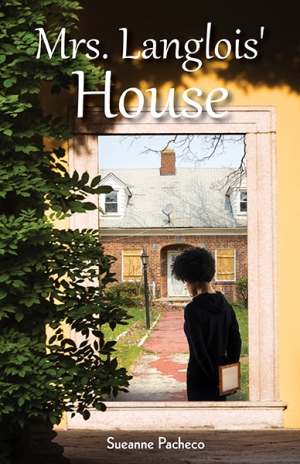Mrs. Langlois' House
Straddling the line between hallucination, magical realism, and the ordinary hormone-fueled weirdness of adolescence, the text is sympathetic and captivating.
Two tough, scrappy heroines, one young and the other old, combine to make Sueanne Pacheco’s Mrs. Langlois’ House a compelling read for older teens.
Seventeen-year-old Nix Baines is having a tougher time than most. Her father has been long out of the picture and she’s constantly at odds with her distracted, overworked mother. At school Nix feels unattractive, isolated, and decidedly friendless. To top everything off, severe pelvic cramps suggest she may have a benign ovarian cyst which, banking on her own bad luck, convinces Nix she’s more likely dying of cancer.
The house of a somewhat mysterious neighbor, Mrs. Langlois, seems like a haven, and Nix begins spending time there. But when Nix’s battle-weary mother sends Nix to live with Mrs. Langlois full-time, the haven begins to feel more like a boot camp.
In Nix and Mrs. Langlois, the book’s two main figures, the magic of character development is on full display. Nix’s anger coruscates on every page, giving the book an almost palpable tension and unpredictability. The text doesn’t specifically note that a good deal of Nix’s anger is mischanneled anxiety over her uncertain medical fate, but the sense of a clouded future looms over the entire story, lifting its emotional pitch from ordinary teen angst to existential dread.
At Mrs. Langlois’s house, Nix soon discovers that her fear, anger, and sassy-rude attitude are no protection at all. Mrs. Langlois, a native of Trinidad, is a long-term survivor who’s preserved both her dignity and authority despite advanced age, a missing front tooth, severe arthritis, and frequent bouts of incontinence. She knows just what Nix needs, and it isn’t sympathy. If Nix wants to stay, she has to pitch in, cleaning, cooking, following Mrs. Langlois’s rules, and helping out when asked.
The slow evolution of the relationship between Nix and her prickly landlady frames the gradual evolution of Nix herself, who discovers she’s not as freakishly isolated as she thinks. Without realizing it, Nix gradually drops her guarded stance and allow bridges to form between herself and others.
The writing is sophisticated and often deliberately ambiguous, shifting scenes abruptly and using language that leaves doubt as to where reality ends and Nix’s emotional projections begin. Straddling the line between hallucination, magical realism, and the ordinary hormone-fueled weirdness of adolescence expands sympathy for angry, confused Nix and keeps the plot sailing along. Dialogue is gritty, realistic, and doesn’t edit out four-letter words.
Like life itself, the book doesn’t end with everything tied in a neat bow. There are more than a few loose ends left flying, and Nix still has challenges ahead of her. In this, the end is a good fit for the story and satisfying to those who’ve come to know and appreciate both Nix and Mrs. Langlois.
With emotional depth, polished writing, and two memorable main characters, Mrs. Langlois’ House by Sueanne Pacheco reaches beyond standard YA fare—and delivers.
Reviewed by
Susan Waggoner
Disclosure: This article is not an endorsement, but a review. The publisher of this book provided free copies of the book and paid a small fee to have their book reviewed by a professional reviewer. Foreword Reviews and Clarion Reviews make no guarantee that the publisher will receive a positive review. Foreword Magazine, Inc. is disclosing this in accordance with the Federal Trade Commission’s 16 CFR, Part 255.


